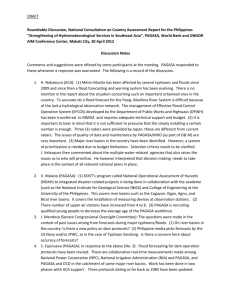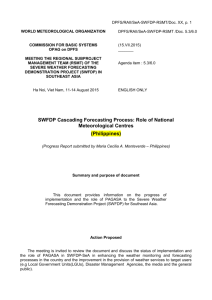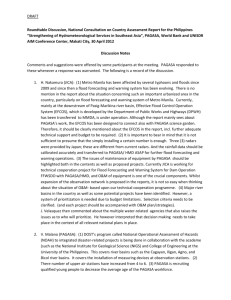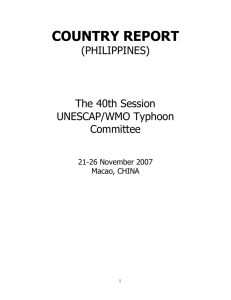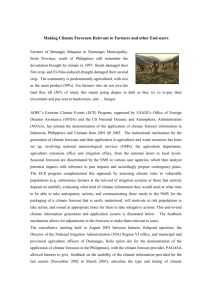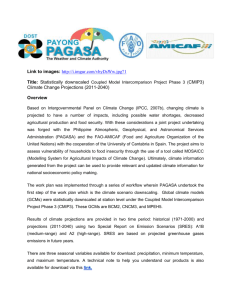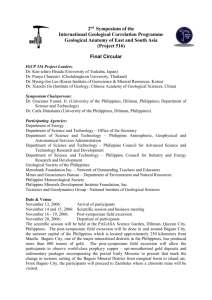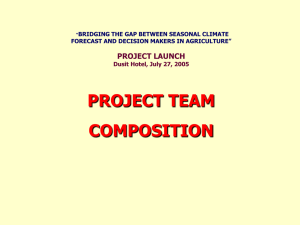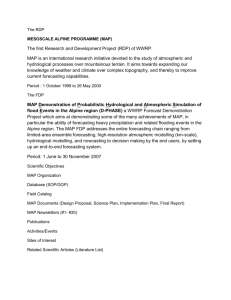National Hydrometeorological Services (NHMS): An Assessment of
advertisement
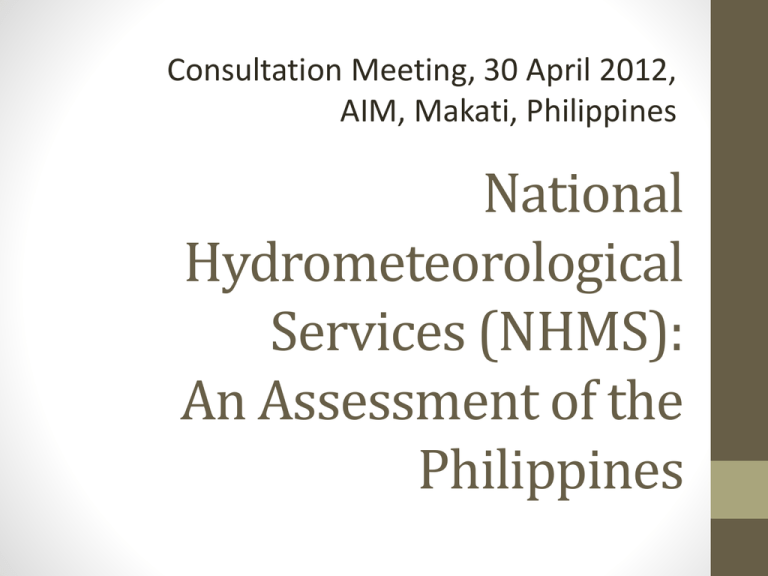
Consultation Meeting, 30 April 2012, AIM, Makati, Philippines National Hydrometeorological Services (NHMS): An Assessment of the Philippines Tasks undertaken • An update and review of the draft report of MMHS under the project “Strengthening Meteorological and Hydrological Services in East Asia” • Mar-Apr 2012; UNISDR AP, Bangkok • PAGASA’s collaboration <Dr. Nathaniel Servando/Nancy Lance, Planning> • Review by staff led by Dr. Susan Espinueva, 19 Apr • Interview with DOST/PCIEERD <Raul Sabularse>, 23 Apr • Review of socio-economic analysis <Danilo Israel> Analysis according to TOR 1. Review existing capacity and infrastructure issues; 2. Assess services needs of user community 3. Identify the existing meteorological and relevant data collection and exchange procedures 4. Identify relevant data-sharing protocols and requirements, considering, standards for hydrological data exchange within and among states; Analysis according to TOR 5. Prepare two investment scenarios for the region assuming that: (a) protocols will be established whereby data are fully and freely, and shared among the member states, and (b) data sharing as it occurs today; 6. Prepare data sharing requirements and standards based on their needs and assuming that capacity will be improved; 7. Prepare detailed investment plans for each country program; 8. Identify potential partnerships between national and international weather agencies based on the technical assistance needs identified in the study. Outline-Draft report (ca 2011) • Executive Summary • Philippine Context • Results of cost benefit analysis • User needs assessment • Philippine NHMS: PAGASA - Organization/Resources - Current services - Network of monitoring stations Outline (Cont’d) • Philippines: NHMS (Continuation) • Maintenance, calibration and manufacturing of monitoring facilities • Numerical weather prediction (NWP) • Information, Communication Technology (ICT) • National & international cooperation and data sharing • Development plans proposed by PAGASA • Summary • Recommendations to strengthen NHMS services • Project proposal Report: Table of contents • Executive Summary • Philippines in a Nutshell (description, economic overview, climate , disaster risk profile, institutional and planning context) • Socio-economic Benefits of HydroMeteorological Services • User Needs Assessment of Hydrometeorological Services & Information • The National Meteorological & Hydrological Services in the Philippines • Current Services of the NHMS • PAGASAs Network for Monitoring Stations (Surface, remote sensing observations) • Maintenance, Calibration & Manufacturing of Monitoring Facilities • Numerical Weather Prediction (NWP) • Information , Communication Technology (ICT) • National & International Cooperation and Data Sharing • Development Plans Proposed by PAGASA • Summary • Recommendations to Strengthen the Meteorological & Hydrological Services • Project Proposal • Persons Met During the Mission • References • Appendices General observations since completion of draft • Significant changes in legal and institutional framework in disaster risk reduction (DRR) and climate change adaptation/mitigation; mainstreaming • Enhanced weather forecasting capacity in terms of hardware • Evolving arrangements in the process of fast tracking mitigation measures for flood and hydromet events • Heightened socio-political dimensions relative to awareness level and Philippine development planning Disasters and NHMS • All sectors realized • the importance of HMS • the need to share data and other information to other NMHS’ in the region. • Establishment of mechanism for publicprivate partnership in disaster reconstruction Assessment of NHMS in the Philippines • Automation program to address need for accurate and frequent updates on severe weather • Doppler radar installation Transport, construction, industry • Tailor-made forecast Agriculture • Upgrading of facilities increase value of forecast products • Pursuing commercialization of some specialized products to private companies and others (aviation, shipping, etc.) PAGASA as NHMS: National set-up • Mandate: to provide weather, climate, agro-met and hydrological services in the Philippines for public safety and in support of economic development; to disseminate official time and provide basic astronomical services. PAGASA as NHMS • Operates & maintains 98% of all hydromet observation networks - aviation met service offices in major airports - Weather, climate and hydrology within PAGASA headquarters • Official forecasts, warnings, advisories, outlooks, press releases on severe weather & extreme events (tropical cyclone, flood, drought, El Nino/La Nina PAGASA plans • Updated Strategic Plan (SP) in line with WMO Regional Association V SP 20122015 <SP2008-2012 Output of 2011 SP workshop> • Long-term Plan/PAGASA Onwards 2020 • R&D-Operations and Services Framework • Investment Portfolio – annual review Planning context • Philippine Development Plan (PDP) 20112016 • National S&T Plan • National Disaster Risk Reduction & Management Plan 2011-2028 • National Climate Change Action Plan 20112038 • Pres. Aquino’s 16-point agenda Philippine Context-PAGASA input • Climate projections using PRECIS/Hadley Centre • Second National Communication to IPCCC • Weather & climate-dependent economic sectors, 61% of GDP: manufacturing <23%>, agriculture <14%>, post/telecommunication <5%>, construction <4.5%>, fishing <4.3%> forestry, land transport, electricity/gas/water supply, mining/quarrying, hotels/restaurants. Profile of PAGASA • “Aging” workforce: 873 staff - 82, R&D; 11, education/training - 11, PhD; 50, MSc: 5, Diploma • 5 Regional Service Division • Modernization program <3-year plan>: • 14 Doppler radars; > 150 automatic weather stations (AWS); 100 automatic rain gauges (ARGs) • 2 Aviation Weather Observing Systems (AWS), 2 marine meteorological buoys, 1 wind profiler, 6 upper air stations, forecast automation • Uninterrupted service 24/7/365 basis • Annual budget: Php817 million (2011) __% increase from 2010 Current Services of PAGASA • • • • • • • • • • • • Weather services Early warning System Climatological and agrometeorological services Hydrological services Marine services Environmental services R&D based Expert services Information services Library services Training services Internet Partnerships with other agencies to expand observing network & data sharing PAGASA’s modernization • Development of a 3-year modernization plan • Additional state-of-the-art equipment, instruments, machines, computers & other facilities • Manpower training & human resource dev. • Strengthening Regional Weather Service Centers • Greater public awareness through education projects/programs PAGASA’s Collaboration • Designated WMO Regional Training Center for South Pacific • Member of Typhoon Committee • UNO: WMO, ICAO, UNESCO, UNDP, UNESCAP • Links with UNEP, IPCC, APCN, ICTP, IOC, COST< APCC, RIMES • Data sharing/Research/Training MOU with NHMCs of Korea, Viet Nam, Mongola • JAMSTEC, DWD User needs assessment: Sectors • Status, government measures • Agriculture, environmental protection/forest management, water resources, energy production & distribution, transport, construction, land use & planning, recreation/tourism, health, insurance, disaster reduction, military, climate change, media PAGASA Gaps/Limitations • Manual production/dissemination of hydromet forecasting & warning services needing data integration & processing • Online hydromet obervations very limited in Visayas & Mindanao • Quality of information is fair because of limited automatic editing and production system • No nowcasts due to lack of appropriate equipment & inadequate skills of technical staff. Institutional capacities: gaps & needs (Table 12.1) Issue Gaps and needs Data - Data rescue of historical climate data is urgently products needed -High performance Data Quality Management system to support NWP system -Integrated database system for NWP data assimilation -Replacement and timely calibration schedule of met. and climate Instruments in some remote stations -Reliable and low-cost observation data communication system needed for efficiency Hazard analysis -Sufficient number of expert in disaster mitigation and risk assessment -Applied R&D products for domestic weather and climate forecasting still relatively limited Institutional capacities: gaps & needs (Table 12.1) Issue Forecasts & warnings EWS expertise & advisory service Gaps and needs - High performance NWP assimilation system in place and operational - Radar and satellite data assimilation and remote sensing-based observation product development - Development of human resources in weather and climate modeling (NWP and climate models) - Flood forecasts showing height and limits of inundation areas - Extended hydrological forecasts - Tailor made forecasts for various sectors Continuous upgrading the skills of PAGASA’s operational staffs to utilize and manage the latest technology instruments and systems Institutional capacities No gaps/needs articulated for • Cooperation with other technical agencies • International • National • Dissemination mechanisms • Communication and media Cooperation with other technical agencies National level • Various Departments: Disaster Risk Reduction and Management, Public Works, Energy, • Agriculture, Health, • Transport, • National Mapping, • Mines &Geoscience, • Civil Defense, etc. • Local/provincial governments • Universities: University of the Philippines, Ateneo de Manila • • • • • • • • • • • • • • • • International level ASEAN’s SCMG JAMSTEC Japan KOICA Korea KMA Korea JICA Japan JMA Japan CMA China DMHCC Vietnam TECO Taiwan Norad Norway UNDP AusAID USTDA USAID ADPC RIMES PAGASA’s Skill Level: Distribution of Rating per Level 36 parameters, 5 levels of rating 2 (5%) 9 (25%) 6 (17%) Level 1: Very bad Level 2: Poor Level 3: Moderate 19 (53%) Level 4: Good Foreseen possibility for sustainable devt Market position Cooperation with media Customer orientation Public appreciation Public visibility Competitiveness Organization Management Competitiveness on labour market Training programme Level of staff education Human resources Webpage Data management Communcation system Maintenance & calibration Environmental obs. Hydrological obs. Network Lightning detection Radar data Upper-air data Surface synop network Support of R&D to main lines R&D Climate change Automated processing/visualization Agrometeorological services Hydrological forecast NWP No. of WF products Weather forecast International cooperation Networking to regional hydromet org Data sharing/GTS Disaster reduction PAGASA’s Skill Level 4.5 4 3.5 3 2.5 2 1.5 1 0.5 0 PAGASA’s Skills: Level rating • Level 1 (Very bad): 2/36 • Lightning detection; environmental observation • Level 2 (Poor): 6/36 • Networking to regional hydromet organizations • Automated processing & visualization • R&D • Radar data • Communication system • Data management PAGASA’s Skill Level Rating Level 3 (Moderate): 19/36 - Disaster reduction Weather forecast No. of WF products NWP Hydrological forecast Agrometeorological services Support of R&D to main lines Surface synop network Hydrological obs. Network Maintenance & calibration • Human resources • Level of staff education Training programme Competitiveness on labour market • Management • Organization • Public appreciation • Customer orientation • Market position PAGASA’s Skill Level Level 4 (Good) • Data sharing/GTS • International cooperation • Climate change • Upper-air data • Webpage • Competitiveness • Public visibility • Cooperation with media • Foreseen possibility for sustainable devt PAGASA Vision • Leading role in hydromet EWS • Provide public access to quality products • Strong advocacy in climate change adaptation • Excellence in tropical cycle forecasting (SEA) • A strong & dynamic organization with inspired & dedicated workforce • Well-managed resources Project Proposal • 5-year investment plan • To improve PAGASA’s services for the benefit of the various socio-economic sectors • Reflects the large increase in operational cost to the government as a results of its modernization • DRR that emphasizes coordination and integrated system of information • User-centered Integration of forecasts, warnings and related information PAGASA’s Commitment • Enhancement of weather forecasting capabilities • HRDP- Improving capacities of PAGASA forecasting personnel • Strengthening flood monitoring, forecasting & warning system • R&D: Strengthening support to climate change adaptation related measures • DRR related S&T program/awareness promotion (incl. establishing a National Meteorological & Climate Center) PAGASA’s Commitment: Enhancement of Weather Forecasting Capabilities • Automated Data Integration, Analysis and Display System for Timely and Reliable Weather Information for Disaster Mitigation and Decision Support • Doppler Weather Radar Program • Rolling-out of Automated Weather Stations, Rain gauges, and Water level sensors • Warning system for Marine Navigation and Transport • Redundant Communication System Doppler radar network showing existing and under implementation Source: Engineering Technical Services Division, PAGASA. Components • International cooperation of experts • Modernization of on-going projects (flood forecasting, radar, wind profiler, marine buoy, AWOS, AWS, high-speed PC cluster computing system, upgrading of tecommunication system, acquisition of equipment • Specialized training involving strengthening of cooperation in SEA for data sharing, information exchange and research collaboration Socio-economic value • For a 20% reduction in damages, improvements from 2010-2020 yield discounted benefits = USD173.70 million Option Costs (USD million) Cost/benefit ratio Stand alone 32.70 1:6.3 With regional cooperation 27.14 1:6.4 Note: (1) C/B ratios are inferior to the 1:7 ratio set by WMO. (2) Regional system is more desirable. (3) C/B ratios would improve if indirect benefits and benefits beyond 2029 are included. Financing • National government & foreign donors • Government counterpart funds & technical personnel in project implementation • Government budget allocation for O&M costs Concluding remarks • The positive direction taken by PAGASA and other stakeholders to reduce disaster risk through hydromet services is proper in the context of WMO. It shall need further tweaking in terms of two major streams: (1) Philippine government’s overall development, and (2) regional demands as evidenced by weather extremes and climate variability. • There is need for a constructive regular dialogue among the major stakeholders from S&T community and users. Next Steps • A regional system to enhance early warning and disaster risk reduction is mainly beneficial to the Philippines in terms of human resource development. • The Philippines can contribute to data/information sharing in the region needing further dialogue among relevant stakeholders.
